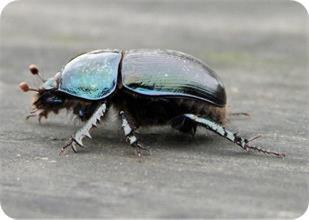Home / Rewilding / Wildlife Successes / Insects
INSECTS
Over 1,800 invertebrate species have now been recorded at Knepp. The group with the most recorded species is Coleoptera (beetles), with 589 species, closely followed by Lepidoptera (butterflies and moths) with 565.
Removing pesticides and avermectins from the system, and leaving deadwood on the land, has triggered a rise in notable beetles: the first record in Sussex for 50 years of the violet dor beetle (Geotrupes mutator) - a type of dung beetle; the rare click beetle (Calambus bipustulatus) whose larvae live in the soft, rotting stumps of old oaks; and the Nationally Scarce Korynetes caeruleus, which feeds on the larvae of wood-boring insects.
Saproxylic (dead wood) invertebrate surveys were carried out as part of the Back from the Brink ‘Ancients of the Future’ project. 252 species were recorded during the surveys, 47 of which had some form of conservation status and 101 of which were saproxylic species. A running total of 129 saproxylic species places Knepp at 11th best site on the Saproxylic Quality Index for Great Britain.
Mayflies and dragonflies throng the messy, vegetative margins of our lakes and ponds now rejuvenated by clean water. Banded and beautiful demoiselles, particularly sensitive to pollution, flit in hundreds over the streams and the surface of the restored River Adur.
Rarer species like the scarce chaser, a blue-eyed dragonfly found only in six places in Britain, are thriving. Eighteen were counted on a transect here in a single day.
Surveying nine areas of the Southern Block over several days in 2015 and 2016, Prof. Dave Goulson of Sussex University recorded 62 species of bee and 30 species of wasp, including seven bee species of national conservation importance such as the red bartsia bee, the rough-backed blood bee, the ridge-cheeked furrow bee (needing desiccation cracks in the clay) and the unusual solitary bee Macropis europaea. It likes to nest in damp or even partially flooded soils and visits exclusively yellow loosestrife for pollen but also for floral oils with which it waterproofs its nest.
